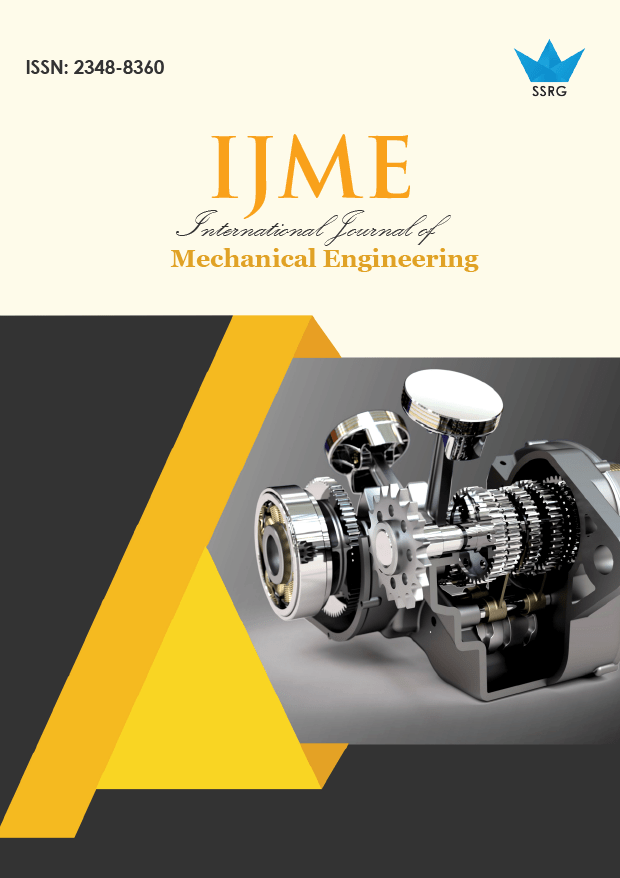Design and Development of Quadcopter Frame Through Topology Optimization

| International Journal of Mechanical Engineering |
| © 2025 by SSRG - IJME Journal |
| Volume 12 Issue 5 |
| Year of Publication : 2025 |
| Authors : Elluru Veera Pratap, Srinivas Pendyala, Kameswara Sridhar Vepa, N. V. S. S. Sagar |
How to Cite?
Elluru Veera Pratap, Srinivas Pendyala, Kameswara Sridhar Vepa, N. V. S. S. Sagar, "Design and Development of Quadcopter Frame Through Topology Optimization," SSRG International Journal of Mechanical Engineering, vol. 12, no. 5, pp. 1-7, 2025. Crossref, https://doi.org/10.14445/23488360/IJME-V12I5P101
Abstract:
Unmanned Aerial Systems (UASs) are gradually gaining popularity in agricultural and defense sectors. Quadcopters are the most common type of UASs due to their inherent advantages, such as mobility, ease, and control. Travelling for a longer period by properly loading may be challenging. The quadcopter's battery depends on its weight in terms of its duration and efficiency. The frame is the structural part of UAS that carries the complete load of the equipment. It is recommended that the UAS frame be optimized because it contributes significantly to the total weight of the UAS, which is about 30 per cent. Current business UAS models consist of many subassemblies and additional hardware fastening points that require substantial time and effort to join. In this research, the frame is transformed into a monocoque structure, which gave good results in terms of weight optimization and time taken for assembly. Topology optimization can thus be used to construct lightweight structures without compromising the structural performance. The design for the quadcopter frame was modeled, and topological optimization was doneto arriveg at the best structure. Topology optimization provided an intricate shape for the model, which was challenging to manufacture through conventional methods; therefore, the optimized model was re-modeled and checked through the statically structural Finite Element Analysis (FEA). The optimized design is then produced through the 3D printing technique. The Powder Bed Fusion (PBF) process is used to create the redesigned quadcopter structure; the field trials indicate that the quadcopter we developed offers users a variety of benefits, including high endurance, greater maneuverability, and a significantly shorter deployment time. Consequently, it is a suitable drone for rapid response in surveillance applications.
Keywords:
Quadcopter, Topology optimization, Unmanned Aerial Systems, Powder Bed Fusion, Additive Manufacturing.
References:
[1] G.D. Goh et al., “Additive Manufacturing in Unmanned Aerial Vehicles (UAVs): Challenges and Potential,” Aerospace Science and Technology, vol. 63, pp. 140-151, 2017.
[CrossRef] [Google Scholar] [Publisher Link]
[2] Helge Klippstein et al., “Fused Deposition Modeling for Unmanned Aerial Vehicles (UAVs): A Review,” Advanced Engineering Materials, vol. 20, no. 2, 2018.
[CrossRef] [Google Scholar] [Publisher Link]
[3] Thomas A. Campbell, and Olga S. Ivanova, “Additive Manufacturing as a Disruptive Technology: Implications of Three-Dimensional Printing,” Technology & Innovation, vol. 15, no. 1, pp. 67-79, 2013.
[CrossRef] [Google Scholar] [Publisher Link]
[4] Tuan D. Ngo et al., “Additive Manufacturing (3D Printing): A Review of Materials, Methods, Applications and Challenges,” Composites Part B: Engineering, vol. 143, pp. 172-196, 2018.
[CrossRef] [Google Scholar] [Publisher Link]
[5] Robin Larsson, “Methodology for Topology and Shape Optimization: Application to a Rear Lower Control Arm,” Master’s Thesis, Chalmers University of Technology, Goteborg, Sweden, pp. 1-53, 2016.
[Google Scholar] [Publisher Link]
[6] Carlo Giovanni Ferro et al., “A Comparison between 3D Printing and Milling Process for a Spar Cap Fitting (Wing-Fuselage) of UAV Aircraft,” Procedia CIRP, vol. 62, pp. 487-493, 2017.
[CrossRef] [Google Scholar] [Publisher Link]
[7] Ionut Stelian, and Sebastian Marian Zaharia, “Design and Testing of an Unmanned Aerial Vehicle Manufactured by Fused Deposition Modeling,” Journal of Aerospace Engineering, vol. 33, no. 4, 2020.
[CrossRef] [Google Scholar] [Publisher Link]
[8] Tomoya Watamura et al., “Flying a Micro-Drone by Dynamic Charging for Vertical Direction Using Optical Wireless Power Transmission,” Energies, vol. 18, no. 2, pp. 1-19, 2025.
[CrossRef] [Google Scholar] [Publisher Link]
[9] Jana Dvorakova, and Karel Dvorak, “Topological Optimization of a Component Made by the FDM Method,” International Journal of Mechanical Engineering and Robotics Research, vol. 10, no. 2, pp. 67-71, 2021.
[CrossRef] [Google Scholar] [Publisher Link]
[10] Silvia Vock et al., “Powders for Powder Bed Fusion: A Review,” Progress in Additive Manufacturing, vol. 4, pp. 383-397, 2019.
[CrossRef] [Google Scholar] [Publisher Link]
[11] Austin T. Sutton et al., “Powder Characterisation Techniques and Effects of Powder Characteristics on Part Properties in Powder-Bed Fusion Processes,” Virtual and Physical Prototyping, vol. 12, no. 1, pp. 3-29, 2017.
[CrossRef] [Google Scholar] [Publisher Link]

 10.14445/23488360/IJME-V12I5P101
10.14445/23488360/IJME-V12I5P101